“The future is determined by the depth and intensity of the vow or pledge embraced by people living in the present moment.” – SGI President Daisaku Ikeda (2015 Peace Proposal)
On August 6 and 9, 1945, 70 years ago, the world witnessed for the first time the usage of weapons that can end all humanity. Nuclear weapons were used on the Japanese cities of Hiroshima and Nagasaki, killing over 100,000 people instantly and tens of thousands of others over the coming years. Today, there are some 60,000 survivors of the atomic bombings of the cities and their average age is 80 years old. Soon, they will no longer be able to tell their own stories.
This year, SGM has made calling for the abolition of nuclear weapons its main battle cry in its Month of Peace activities. One of the key activities towards this end is the “Everything You Treasure: For a World Free from Nuclear Weapons” exhibition (EYT). Since June, SGM members throughout the country have been actively promoting EYT in their local communities, especially in schools.
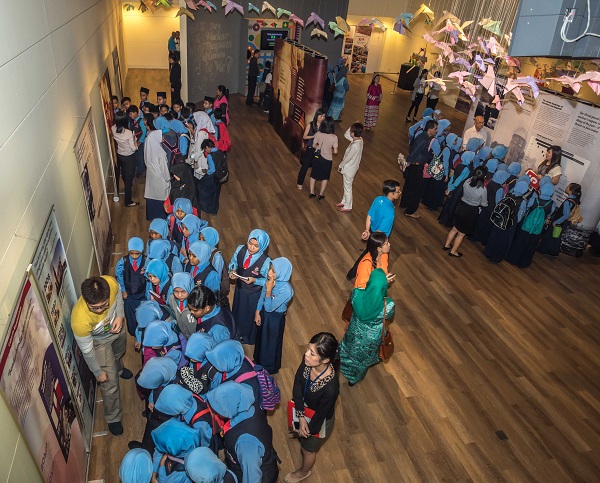 |
| Kuala Lumpur |
In Kuala Lumpur, EYT opened on August 8 at Wisma Kebudayaan SGM (SGM), and the official opening ceremony was held on August 9 in a packed auditorium. It opened with the performance of a medley of John Lennon’s “Imagine” and Zainal Abidin’s “Hijau” by SGM culture groups consisting of dance, vocal and instrumental performers.
SGM General Director Koh Sia Feai then gave his welcoming speech. He noted that with the existence of nuclear weapons, the extinction of humanity is possible, and awareness towards the 16,000 nuclear weapons that still exist is in danger of fading. EYT is an avenue to spread awareness towards these demonic weapons and inspire people to make the abolition of nuclear weapons their personal cause.
He also spoke about the genesis of the SGI’s peace activism, which is second Soka Gakkai president Josei Toda’s “Declaration Calling for the Abolition of Nuclear Weapons”, made on September 8, 1957 in the presence of 50,000 youth in Yokohama. Toda condemned nuclear weapons as the embodiment of absolute evil and manifestation of the demonic spirit that exists within human life. He willed this work of abolishing nuclear weapons to the youth.
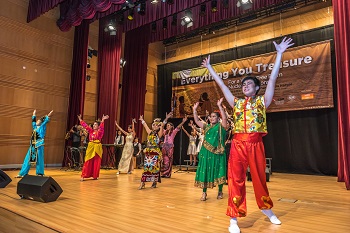 |
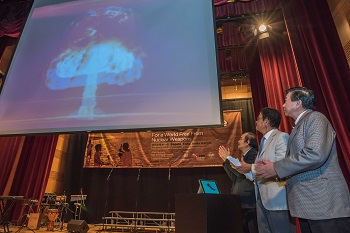 |
| Opening Ceremony in Kuala Lumpur | |
SGI President Ikeda, who was 29 years old at that time, inherited Mr Toda’s spirit and expanded upon his efforts. He embarked on efforts to create a culture of peace throughout the world, which included conducting dialogues with leading world leaders and thinkers, publishing annual peace proposals and supporting the efforts of the United Nations. Mr Ikeda has consistently advocated for the solidarity of the people in overcoming the world’s most pressing challenges.
Mr Koh remarked that though great challenges lay ahead, we must not give up hope. The abolition of nuclear weapons can definitely be achieved, noting that there are international treaties banning the use of landmines, cluster munitions and chemical weapons. He urged those who view the EYT to deepen awareness towards nuclear weapons abolition, reflect on their attitudes and reject ways of life that promote violence and work towards outlawing nuclear weapons.
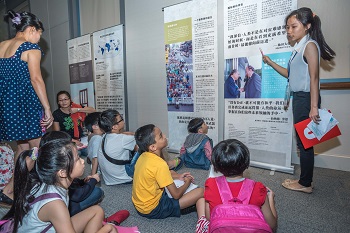 |
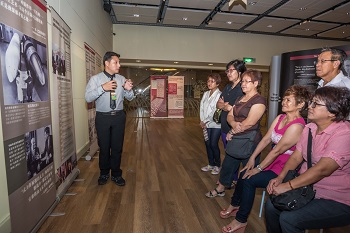 |
| Kuala Lumpur | |
A video titled No More Hiroshimas, No More Nagasakis by the International Campaign to Abolish Nuclear Weapons (ICAN) was then screened. ICAN is the co-creator of EYT, along with the SGI. The video called on people to wipe out the existence of these demonic weapons.
Next to take the stage was the guest-of-honour, Tan Sri Razali Ismail, the chairman of the Global Movement of Moderates Foundation (GMMF). Tan Sri Razali had a 35-year distinguished career in the diplomatic services and held various key posts. He served as Malaysia’s envoy to Poland and India, chairman of the UN Security Council and president of the UN General Assembly.
He praised the SGI’s perseverance and dedication in working for the abolition of nuclear weapons despite the many hindrances and obstacles. He gave an overview of the history of the development of nuclear weapons, stressing that human beings are prone to errors and a nuclear war can be launched accidentally. He cited five instances when the world came close to nuclear war, such as the Cuban Missile Crisis. It would not be possible to form a meaningful humanitarian response to a nuclear weapon detonation, such as in Hiroshima where 90% of all medical personnel were instantly killed in the bombing.
He spoke on Malaysia’s efforts in pushing for the abolition of nuclear weapons on the international stage, such as her efforts in introducing a model Nuclear Weapons Convention with other nations. The nations of ASEAN have also made Southeast Asia a nuclear weapons-free zone through the 1995 Bangkok Treaty, which was eventually ratified by all member states in 1997.
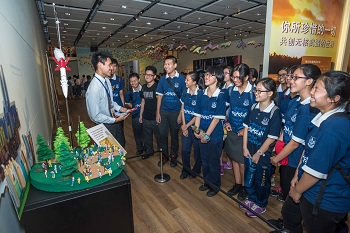 |
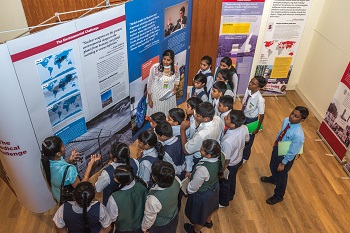 |
| Kuala Lumpur | |
“Hiroshima and Nagasaki will continue to be a blot on our conscience, a blot on our humanity, if in our time we are unable to eliminate completely the utilisation or the threat of use of weapons of mass destruction….Nuclear disarmament is not just an ideal; it’s a necessity. As long as nuclear weaponry exists, there can be no true peace. ” He urged all present to continue to fight for a world that is free from nuclear weapons.
Tan Sri Razali, Mr Koh and SGM President Michael Kok then opened the exhibition. Tan Sri Razali and other guests were then given a tour of the exhibition. Guests included Dato’ Dr Ronald McCoy, former co-president of the International Physicians for the Prevention of Nuclear Warfare (IPPNW) and eminent nuclear weapon abolition activist; Prof Tan Sri Dzulkifli Abdul Razak, president of the International Association of Universities; Dato Salman Khan, senior fellow at GMMF and former Malaysian ambassador, and Dato’ Seri Kee Yong Wee, adviser to the Calligraphy Society of Malaysia.
Tan Sri Razali remarked that he was especially pleased to see so many SGM youth being involved in the exhibition.
In Perak, EYT also opened on August 8 at the SGM Perak Culture Centre in Ipoh, ending on August 16. The exhibition was officially opened that day by Tuan Hj Rozi Puteh Ismail, Director of the Perak State Education Department.
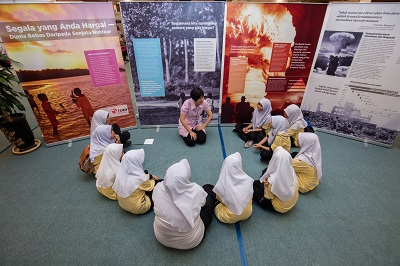 |
| Perak |
In his welcoming speech, SGM Perak representative Tan Sai Hoi remarked that as part of its efforts to call for the establishment of a world without nuclear weapons, SGM Perak hopes that through this exhibition, we can increase the awareness of the public towards the issue of nuclear weapons, raising its profile as a vital issue and help build consensus towards the abolition of nuclear weapons.
In his speech, Tuan Hj Rozi said that it is important that we learn from the mistakes we made in the past and work towards building a better future that will be cherished by all. The history of nuclear weapons is one that we have to change. Following the speech, Tuan Hj Rozi, SGM Perak Chairman Lai Soo Ha, and SGM Perak representatives Wong Tuck Wah and Tan Sai Hoi jointly opened the exhibition.
Other guests include Dato’ Dr Fadzli Cheah Abdullah, Chairman of Malaysian Chinese Muslim Association-Ipoh (MACMA-Ipoh) and wife, MACMA-Ipoh Deputy Chairman Hafiz Ng Abdullah, prominent Perak artists, school principals, teachers and students. On that day, over 600 students visited the exhibition.
From August 6 to 9, SGM Sarawak held EYT at the CityOne Megamall in Kuching. It was opened on August 6 by YB Datuk Seri Dr Wan Junaidi Tuanku Jaafar, Minister for Natural Resources and the Environment.
In his welcoming speech, SGM Sarawak Honorary Secretary Tay Thing Swee said the exhibition aims to create awareness of peace in society and strive for the ban and abolition of nuclear weapons.
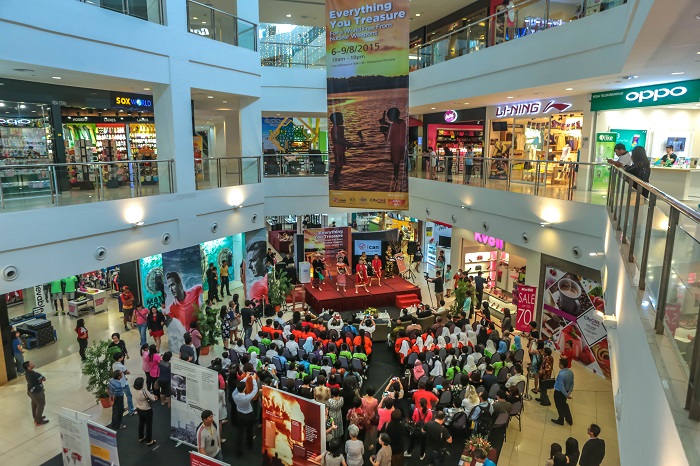 |
| Sarawak |
Datuk Seri Dr Wan Junaidi commended SGM for organising the exhibition. “It is important for SGM to remind the public on the wrong use of nuclear science…Awareness is important for people to understand that we cannot go to war in any form, especially involving nuclear weapons, which can destroy the world ten times over. The whole of humanity will be wiped out.”
Also present at the opening ceremony were Brunei Consul-General in Sarawak Tuan Kamsani Noordin, Republic of Indonesia Consul-General Bapak Dr Jahar Gultom and other community leaders.
During the 4-day period, over 3,200 people came to view the exhibition held here.
EYT Opening Impressions
Tan Sri Razali Ismail
GMMF Chairman and former president of the United Nations General Assembly
I am very happy to be back here for this very important exhibition. People need to be reminded of what happened in Hiroshima and Nagasaki, lest they be forgotten. The commitment towards abolishing nuclear weapons is not just about preventing what has happened before, but to prevent what COULD happen.
The involvement of the young people here is heartening. The degree of knowledge they have on issues regarding nuclear disarmament is very relevant to Malaysia. We must get more young people to be involved in these issues. The threat posed by nuclear weapons must be seen as more urgent than the threat posed by climate change. Ordinary citizens must pressure their governments to in turn pressure the nuclear weapon states into giving up these weapons.
Prof Tan Sri Dzulkifli Abdul Razak
President of the International Association of Universities (IAU)
The exhibition is a fantastic one. The way the things are being displayed, including graphics, statistics and texts are effective. The visual impacts are also high. The boards are also presented in three languages – Bahasa Malaysia, English and Chinese – which will spread the peace messages more widely.
When the Hiroshima atomic bomb went off, my late father, Datuk Abdul Razak Abdul Hamid, was studying Mathematics in Hiroshima. He was 1.5 km away from the hypocentre when the bomb detonated 600 metres above the ground. When the B-29 plane flew by, a siren went off but people did not have the time to run to bomb shelters when the blast reached them.
When my father woke up later, he was lying in rubble. He survived unharmed, even though the atmosphere was full of radioactivity. His survival is considered a miracle and we believe that it was due to his rich spirituality. He was a religious man, practised non-violence and lived in peace with himself and with his family at home. He never raised a hand in disciplining us. Hence, the love for peace was inculcated in our lives. Having learned this, it will be easier for them to be peaceful with the others in the society. We all have a lot to learn from each other.
I would also like to see an interactive section aimed towards young people so as to draw more young people to the exhibition and learn more about the dangers of nuclear weapons. This section would make use of modern technologies such as tablets or smartphones. I would also display more photos of the painful effects of nuclear weapons on the victims – to drive home the message on how terrible such weapons are. I have also found that certain drawings of the after-effects of such weapons very memorable.
Dato’ Dr Ronald McCoy
Former co-president of IPPNW and past president of the Malaysian Medical Association
This is a very extensive and educative exhibition. Another important thing you have done here is producing Bahasa Malaysia and Chinese versions of the exhibition. The foresight in holding this exhibition is really important, especially in getting schoolchildren to view this.
I am working with various organisations, one of which is the IPPNW, in order to make nuclear weapons illegal via treaty on humanitarian grounds. The usage of nuclear weapons has such enormous consequences for which there is no possible medical or humanitarian response.
Dato’ Salman Ahmad
Senior Fellow, GMMF and former Malaysian ambassador
SGM is making a good effort to raise awareness on the dangers facing humanity and the magnitude of the damage caused by nuclear weapons. Having the exhibition in three languages can reach a wider audience.
Only a few countries have nuclear weapons but they make us wonder if they really care about how others feel. We need to make them realise that life is important and has dignity. We can help influence them through the GMMF and our colleagues in ASEAN and the UN. We must influence more people to speak out against nuclear weapons. Malaysia is currently in the UN Security Council and we can play an important role and encourage more people to join our cause.
Tuan Hj Rozi Puteh Ismail
Director, Perak State Education Department
This exhibition creates awareness in society, especially among students, that if we want to live in peace, we have to do away with nuclear weapons. This exhibition not only sends a clear message to us but also to the international community that there is a need to abolish these weapons altogether.
Dr Lai Kuan Fook
Adviser, Young Buddhist Association of Malaysia
I have great respect for GMMF Chariman Tan Sri Razali Hamzah who has served extensively in the UN.
While human beings are the most advanced of living beings, they have also invented nuclear weapons that can destroy us all, and that is very foolish indeed. It is important that we use our wisdom to protect life. It is significant that SGM is holding this exhibition in this year of the 70th anniversary of the atomic bombings and end of World War 2.








